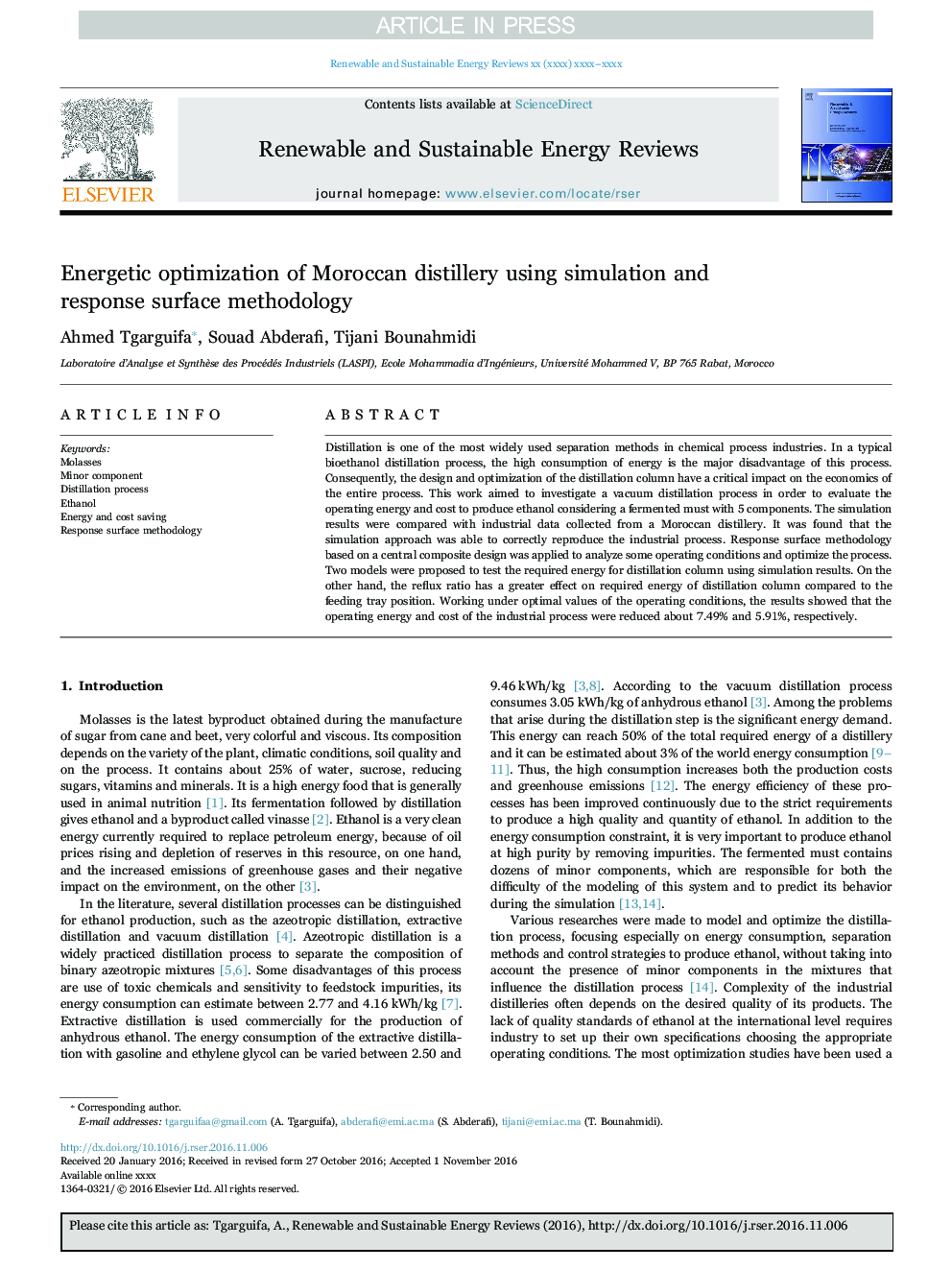| کد مقاله | کد نشریه | سال انتشار | مقاله انگلیسی | نسخه تمام متن |
|---|---|---|---|---|
| 5482849 | 1522311 | 2017 | 11 صفحه PDF | دانلود رایگان |
عنوان انگلیسی مقاله ISI
Energetic optimization of Moroccan distillery using simulation and response surface methodology
ترجمه فارسی عنوان
بهینه سازی انرژی کارخانه فرانسوی مراکش با استفاده از روش شبیه سازی و سطح پاسخ
دانلود مقاله + سفارش ترجمه
دانلود مقاله ISI انگلیسی
رایگان برای ایرانیان
کلمات کلیدی
ملاس جزئی جزئی، روند تقطیر، اتانول، انرژی و صرفه جویی در هزینه، روش سطح پاسخ،
ترجمه چکیده
تقطیر یکی از روشهای جداسازی در صنعت شیمیایی است. در یک فرآیند تقطیر معمول بیوتکنول، مصرف انرژی بالا، ضرر اصلی این فرآیند است. در نتیجه، طراحی و بهینه سازی ستون تقطیر تاثیر بحرانی بر اقتصاد کل فرآیند دارد. این کار با هدف بررسی فرآیند تقطیر خلاء به منظور ارزیابی انرژی عملیاتی و هزینه تولید اتانول با توجه به نیاز به تخمیر شده با 5 مولفه انجام شد. نتایج شبیه سازی با داده های صنعتی جمع آوری شده از کارخانه فرآوری مراکش مقایسه شد. یافته شد که رویکرد شبیه سازی قادر به تولید پروسس صنعتی بود. روش سطح پاسخ بر اساس یک طراحی مرکزی مرکب برای تحلیل برخی شرایط عملیاتی و بهینه سازی روند استفاده شد. برای تست انرژی مورد نیاز برای ستون تقطیر با استفاده از نتایج شبیه سازی، دو مدل پیشنهاد شده است. از سوی دیگر، نسبت رفلکس تأثیر بیشتری بر انرژی مورد نیاز ستون تقطیر نسبت به محل سینی تغذیه دارد. نتایج بدست آمده نشان می دهد که انرژی عامل و هزینه فرآیند صنعتی به ترتیب 7.49٪ و 5.91٪ کاهش یافته است.
موضوعات مرتبط
مهندسی و علوم پایه
مهندسی انرژی
انرژی های تجدید پذیر، توسعه پایدار و محیط زیست
چکیده انگلیسی
Distillation is one of the most widely used separation methods in chemical process industries. In a typical bioethanol distillation process, the high consumption of energy is the major disadvantage of this process. Consequently, the design and optimization of the distillation column have a critical impact on the economics of the entire process. This work aimed to investigate a vacuum distillation process in order to evaluate the operating energy and cost to produce ethanol considering a fermented must with 5 components. The simulation results were compared with industrial data collected from a Moroccan distillery. It was found that the simulation approach was able to correctly reproduce the industrial process. Response surface methodology based on a central composite design was applied to analyze some operating conditions and optimize the process. Two models were proposed to test the required energy for distillation column using simulation results. On the other hand, the reflux ratio has a greater effect on required energy of distillation column compared to the feeding tray position. Working under optimal values of the operating conditions, the results showed that the operating energy and cost of the industrial process were reduced about 7.49% and 5.91%, respectively.
ناشر
Database: Elsevier - ScienceDirect (ساینس دایرکت)
Journal: Renewable and Sustainable Energy Reviews - Volume 75, August 2017, Pages 415-425
Journal: Renewable and Sustainable Energy Reviews - Volume 75, August 2017, Pages 415-425
نویسندگان
Ahmed Tgarguifa, Souad Abderafi, Tijani Bounahmidi,
